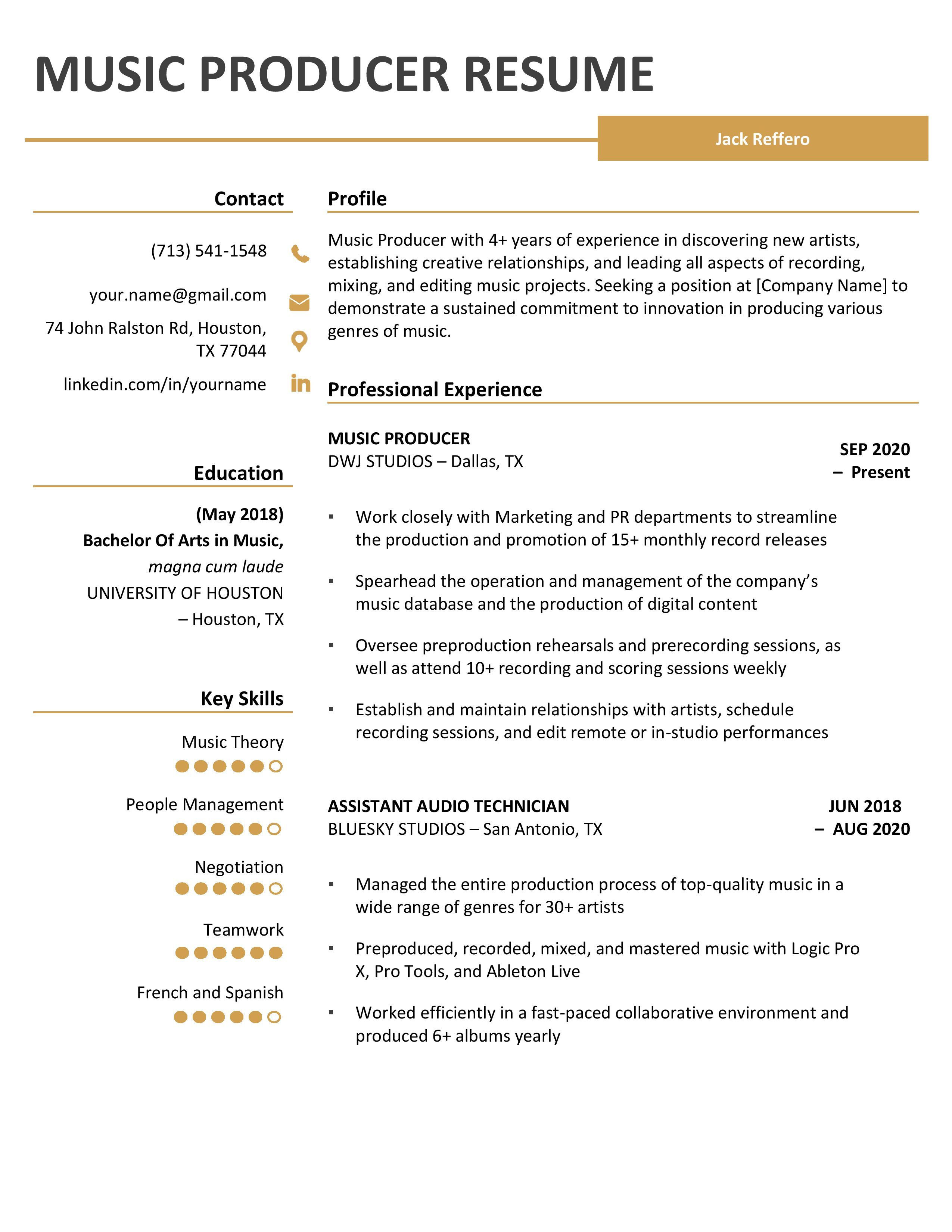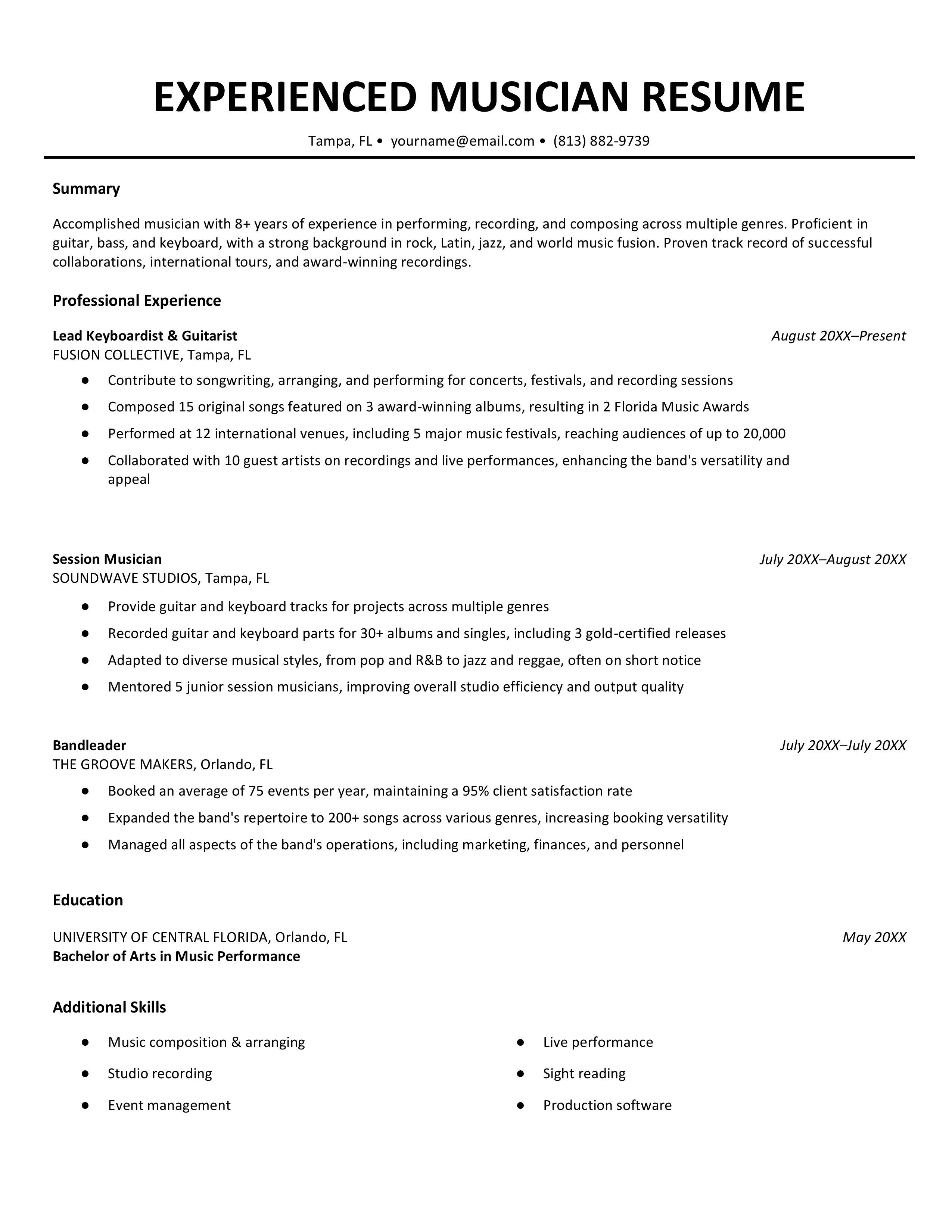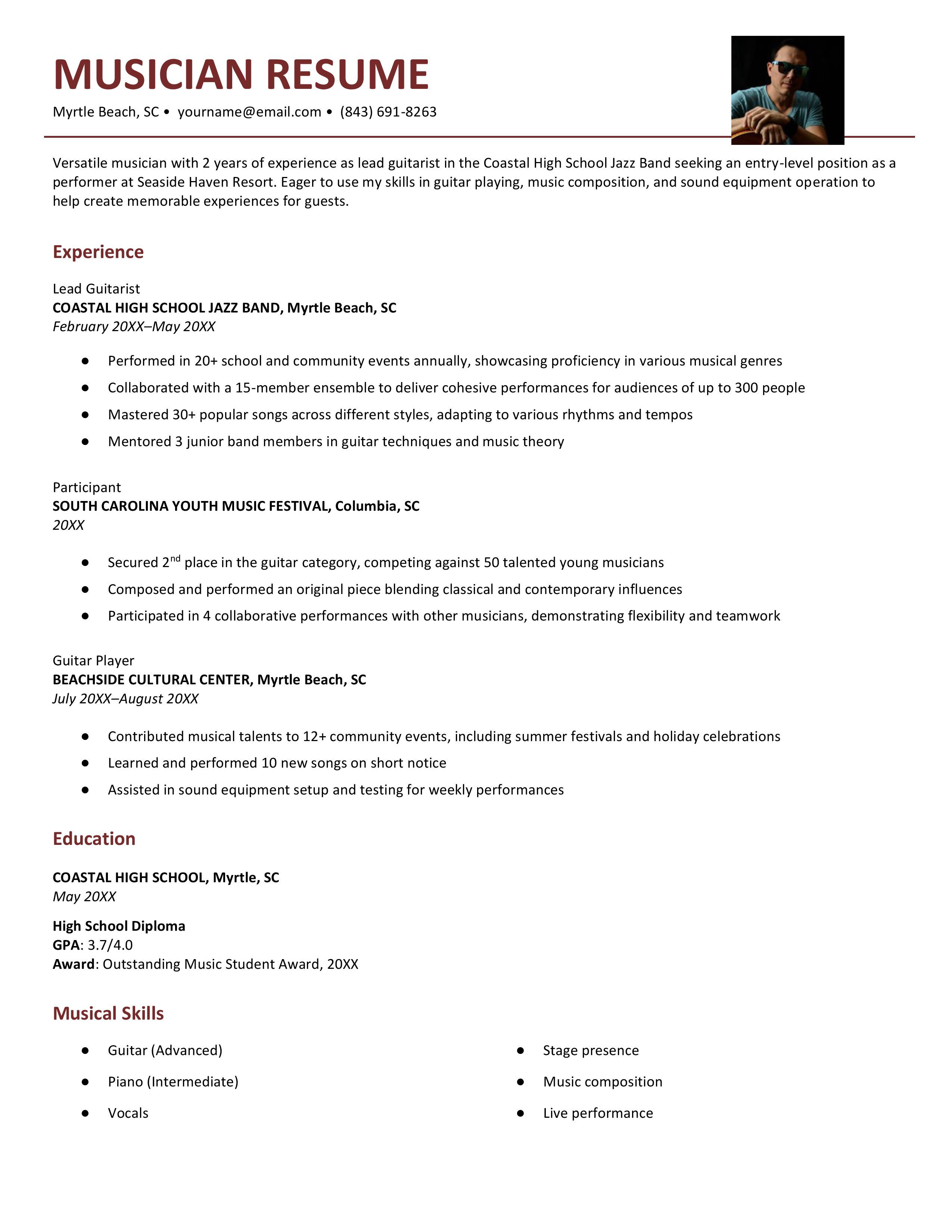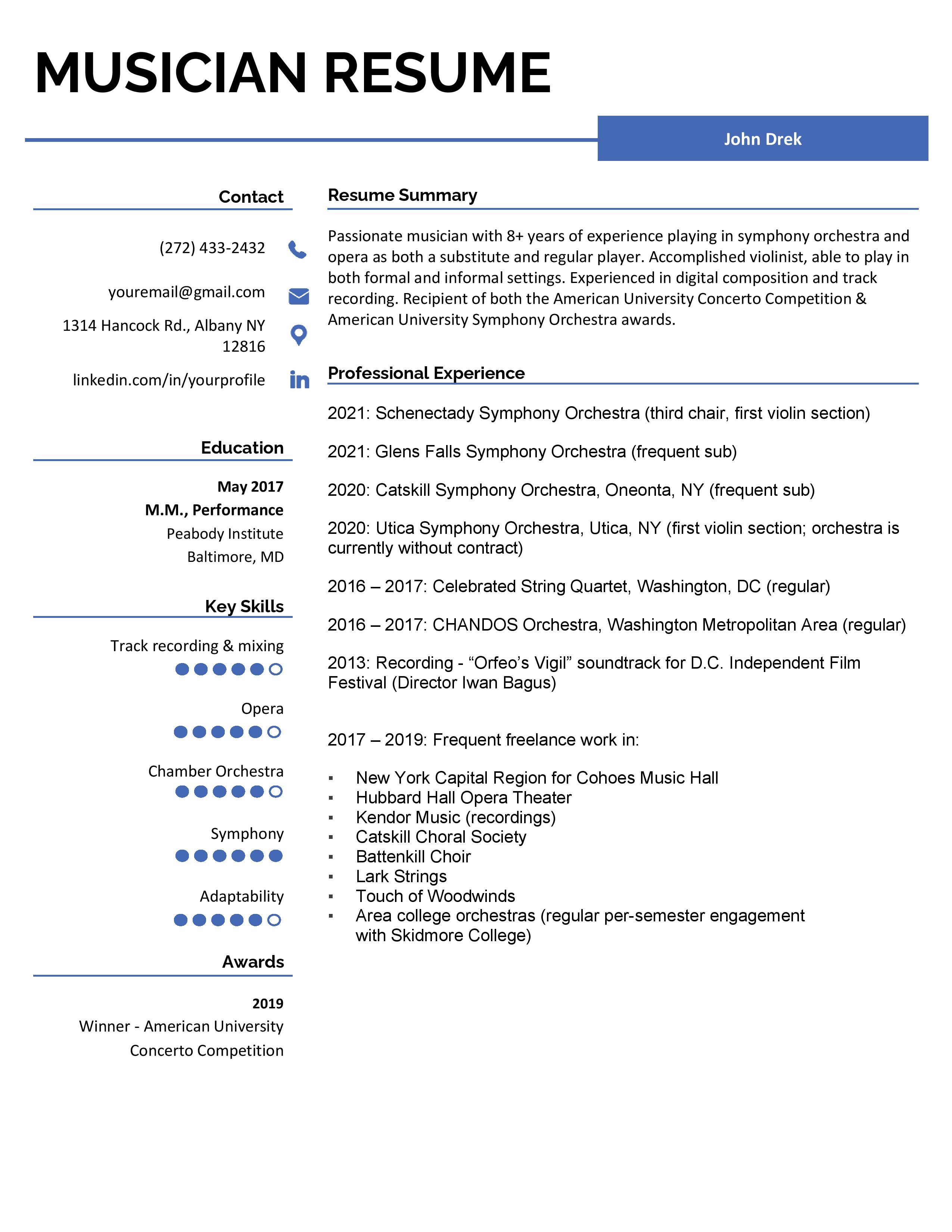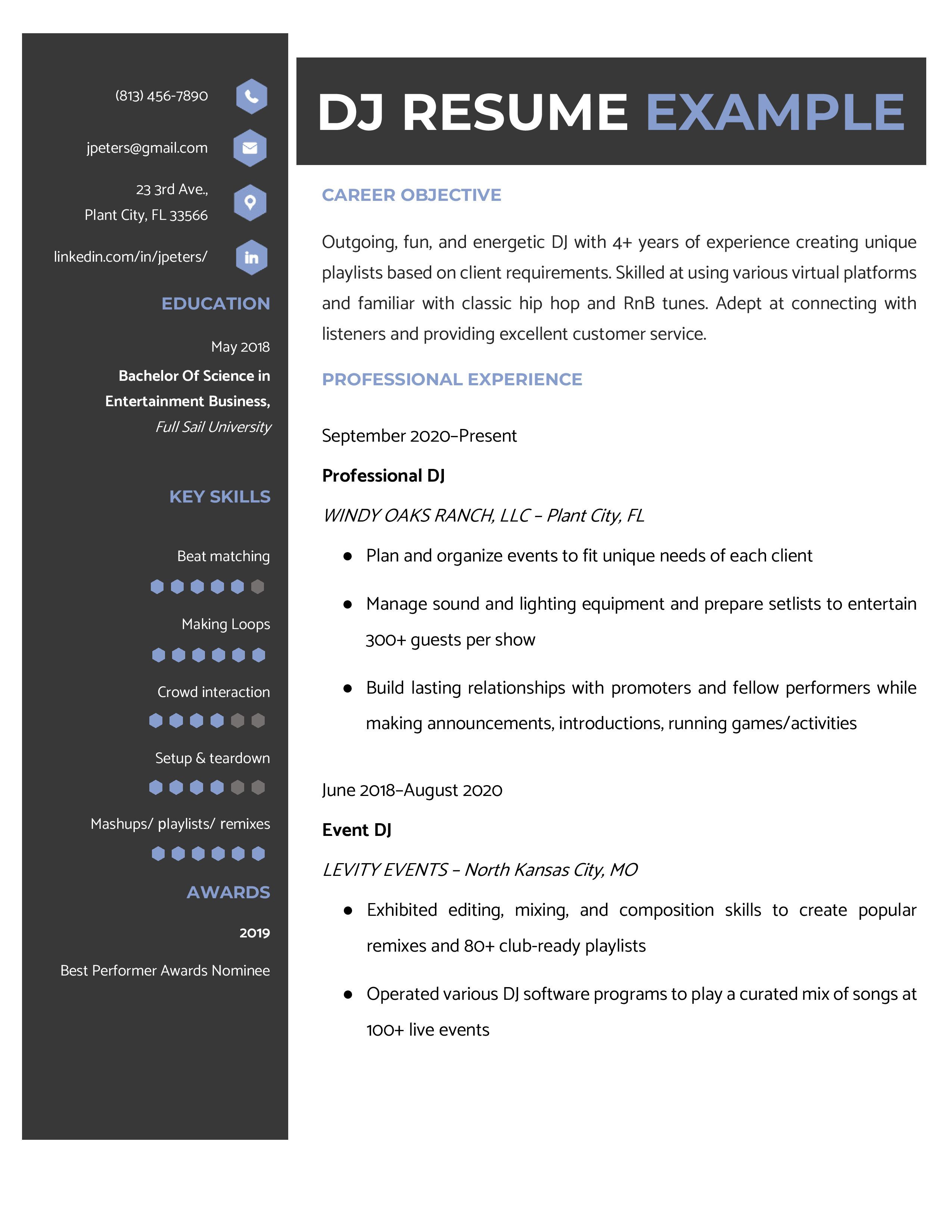Musician Resume: Showcase Your Talent & Experience
Published on November 5th, 2024
Preparing a musician's resume is not just a matter of listing skills and jobs. As a musician, your resume needs to reflect your artistry, experience, technical skills, and accomplishments in a way that resonates with potential collaborators, employers, and booking agents. Whether you are an instrumentalist, vocalist, composer, or music producer, this guide will help you design a resume that stands out and captures the essence of your musical journey.
Here are some sample resume templates -
Template 1
1. Start with a Strong and Focused Summary
This summary should emphasize your skills, experience, and musical style within a concise and descriptive paragraph. Generally, this should encapsulate your artistic identity and relevant achievements in 2-3 sentences.
Example:
"Versatile and dynamic jazz saxophonist with over a decade of experience performing internationally in ensembles, orchestras, and as a solo artist. Known for soulful improvisation and technical proficiency, with a background in classical training and a passion for live performances."
This summary captures the musician's genre, years of experience, and performance scope, making it clear what kind of artist they are and what they bring to the table.
2. Professional Experience
For musicians, "Professional Experience" is a record of performance history, tours, notable gigs, and residencies. List it chronologically, but each entry should include role, such as Lead Guitarist or Singer, name of the band or organization, location, and performance dates.
Tips for Accentuating Experience:
High-profile performances or collaborations.
Residencies or notable venues you have performed at.
Ongoing or past tours and collaborations.
Example:
Lead Guitarist
Blue Note Jazz Club, New York, NY | 2021 - Present
- Played weekly at one of NYC's top jazz clubs, with packed crowds and rave reviews.
- Played with jazz and blues legends, adding improvisational spice and technical mastery to group performances.
Resident Pianist
Royal Caribbean Cruises | 2019 - 2021
- Played solo and ensemble piano on a variety of luxury cruises, entertaining a diverse, international crowd.
- Prepared setlists to accommodate the audiences' preferences and the requirements of the venues.
3. Highlight Your Education and Training
Many artists have excellent formal education and training. Be sure to include any Music-specific degree, diploma, or certificates. This would include attendance at music schools, conservatories, or private tutors specifically for a type of instrument or technique. If applicable, list notable instructors or mentors that you studied under.
Sample:
Bachelor of Music in Jazz Performance
Berklee College of Music | Graduated: 2018
Focused on jazz saxophone with a focus on improvisation with Grammy nominated saxophonist Eric Marienthal.
4. Add a Section for Key Skills
Technical skills, besides soft skills, form a musician's skills section. Note your technical skills – like instrumental proficiency, audio engineering, or composition software - but also note your artistic qualities.
Technical Skills Examples:
- Instrumental Proficiency: Piano, Saxophone, Guitar, Drums
- Production Software: Ableton Live, Pro Tools, Logic Pro
- Composition and Arrangement
- Sight-Reading and Ear Training
- Examples of Soft Skills
- Collaboration and Teamwork
- Flexibility of Performing in Various Environments
- Stage Presence and Audience Relation
- Combining both technical and soft skills gives one a holistic picture of professionalism as a musician and art worker.
5. Mark any notable performances or other key milestones
This section is very crucial to artists because it showcases the work of the musician. Add the albums, EPs, and singles that have been recorded or released. To those who perform live, record notable venues or festivals they have performed in as well as awards or recognition.
Here is an example:
Discography and Notable Performances
Live at the Blue Note (Album, 2022) Recorded live at the Blue Note Jazz Club, NY.
Sunset Serenade (Single, 2021) – Featured on Spotify's Jazz New Releases playlist.
Live shows: Montreux Jazz Festival, Switzerland, 2020; SXSW Music Festival, Austin, TX, 2019.
6. List Awards, Honors, and Recognitions
Awards and recognitions will make you more credible and differentiate you from other musicians. These awards show the world your talent and dedication to your craft. If you have won any music awards, scholarships, or appeared in prominent media outlets, include them here.
Example:
Awards and Honors
DownBeat Student Music Awards 2018 Jazz Soloist Award
Scholarship Recipient, Berklee College of Music 2015
Featured on JazzTimes "Rising Artist to Watch" 2019.
7. List any teaching or mentoring experience
If you have taught music or mentored students, this will reflect leadership ability, knowledge, and a passion for sharing music with others. Provide private lessons, teaching at music schools, or any mentorship programs you have been involved in.
Private Music Instructor (Piano and Theory)
Self-Employed | 2018 - Present
Designed and implemented lesson plans for varying age ranges and skill levels
Students developed technical ability, musicality, and performance confidence.
8. Customize Your Resume to Job Opportunities
Different types of music work may require different formats of resumes. For example, if it is teaching, make sure that educational background and teaching experience will be emphasized. In a case of performance, focus on live shows, collaborations, and releases. Making a resume in this fashion will help you get one that will work best for the kind of work you are applying for.
9. Include a portfolio or media links.
A musician's resume is actually made stronger by a portfolio or links to recordings, performances, or professional website. Include a section of links to your music hosted on YouTube, SoundCloud, or Bandcamp, for instance. That way, the potential employer gets first-hand experience of your talents.
Examples:
Live Performances: YouTube Channel
Music Portfolio: SoundCloud Profile
Website: www.YourNameMusic.com
10. Professional and Brief
Even though a resume for a musician can get pretty creative, keep it clean and concise. A two-page resume may work with highly experienced candidates, but for most jobs, a one-page resume is the best because it immediately catches peoples' attention. Design it on a clean format using good readable fonts and place clear headings between sections.
Final Words
Writing a musician's resume is not merely about putting down previous jobs, but more about the journey, creativity, and achievements that reflect the music world. Having such a well-crafted resume that presents the different talents and contributions of your own, you are good to go to win the interest of any musical opportunity-whether it be an audition or gigs, collaborations, or teaching jobs.
All the best and keep the music alive!
Authors

Yash Chaudhari
With a strong background as an SEO and Content Specialist, Yash excels in driving organic traffic, improving search engine rankings, and creating SEO-optimized content. He has a proven track record of implementing strategies that increase website traffic and conversions. Additionally, Yash is an automotive enthusiast and has a keen interest in astronomy.
Hire the best without stress
Ask us how
Never Miss The Updates
We cover all recruitment, talent analytics, L&D, DEI, pre-employment, candidate screening, and hiring tools. Join our force & subscribe now!
Stay On Top Of Everything In HR

